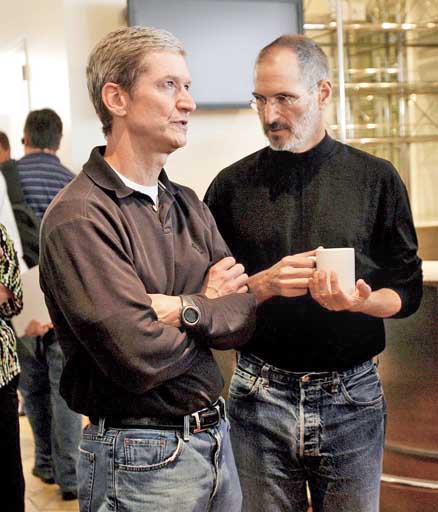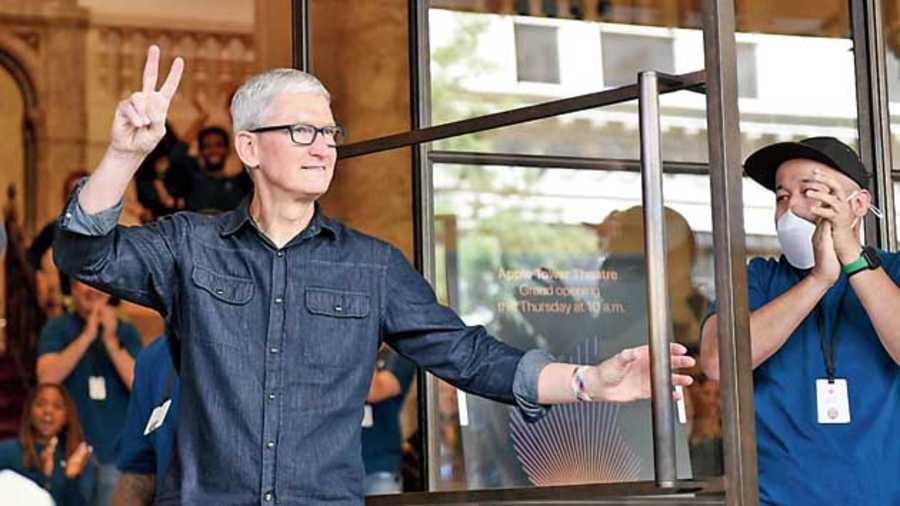Rarely have we seen a global company dominated by one individual. Steve Jobs and Apple are synonymous. The man first redefined personal computers, then the music business with the iPod, followed it up with the smartphone in the form of the iPhone and then delivered the iPad. He knew what the customer would want. But pancreatic cancer took a toll on his health and a couple of months before he passed away on October 5, 2011, he left the company in the able hands of Tim Cook under whose watch Apple has thrived, to say the least. As CEO, Timothy Donald Cook has kept alive Jobs’s clarity of vision while taking Apple in a new direction.
Products to services and subscriptions
Under Cook, Apple has moved up from Jobs’s era of a comparatively small product line-up to several versions of MacBooks, iMacs and iPhones. Plus, Apple’s foray into services is finally paying off in a big way. Ten years into his job, more than a billion people globally use Apple’s iPhones, besides tens of millions of developers have managed to develop businesses on its software platforms.
The man ensures that Apple continues to set benchmarks for the tech industry while walking a political tightrope unlike Jobs. Besides devices, Apple’s businesses range from an Oscar-nominated TV and film production studio to payment services. Under him, more than 100 companies have been acquired, including the $3 billion Beats purchase in 2014 and the $1 billion acquisition of Intel’s smartphone modem business in 2019. Very importantly, he has managed to solve a lot of problems in the supply chain and with Apple making its own silicon, there’s no stopping the company’s growth. And then there’s the framework Apple has come up with to deal with privacy issues.
“From my point of view, Steve — his spirit will always be the DNA of the company. He embodied who we are. It was his vision that Apple should make the best products, and it was his vision that they should enrich people’s lives. Lots of other things will change with Apple, but that will never change,” Cook said during a public appearance at the Utah Tech Tour in 2016.
Today, Apple is the most valuable publicly-traded company, worth more than $2.4 trillion. Yes, devices remain an important part of the bottom line but giving thrust to the company’s market cap are software subscriptions like iCloud, Apple Music and App Store downloads, AppleCare warranties. When smartphone growth started somewhat stagnating in 2015, Cook and his team were ready. What followed has been Apple TV+, a competitor to Netflix, which is slowly building up an excellent catalogue. Also, Apple One, Apple News+ and Apple Arcade.
New products have also buoyed the growth — the Apple Watch in 2015 has become synonyms with one of the best lifestyle gadgets money can buy while AirPods, which arrived in 2016, has inspired other companies.
The no-nonsense negotiator
During President Donald Trump’s volatile four years, Cook managed to do the impossible. On the one hand, the CEO severely criticised Trump’s statements defending white supremacists and other extremists at a deadly rally in Charlottesville, and on the other he invited the moody man to Apple’s Mac Pro manufacturing plant in Austin, Texas. The company also managed to maintain important ties with China, where Apple has a huge customer base, besides a crucial supplier relationships.
In 2019, at a White House event, Trump thanked Tim Cook for his efforts to bolster the American workforce. “You’ve really put a big investment in our country,” the President told Cook, who was sitting to his right. He continued: “We appreciate it very much, Tim Apple.” It was a goof up like Trump’s many goof ups but he did have a point. Business thrived (and continues to) for Apple during that period.
Cook joined Apple in 1998 after spending a number of years at IBM Corp and a short stint at Compaq. At first, Cook only wanted to meet Jobs. “The way that he talked, and the way the chemistry was in the room, it was just he and I. I looked at the problems Apple had, and I thought you know, I can make a contribution here. And working with him, and this is a privilege of a lifetime. And so all of a sudden I thought, I’m doing it. I’m going for it...,” he told Charlie Rose in 2014.
The secret sauce that has taken him to the top is actually simple: Work, work, work. There have been reports that he has 18-hour days, sending emails through the night. While Jobs spoke about amazing hardware, behind the scenes Cook was always hard at work, ensuring the supply chain was never broken.
And another success under his tenure has been championing user privacy, calling it “a fundamental human right”. The company has famously fought the FBI over requests that, privacy advocates agreed, might lead to governments having backdoors into users’ phones. We now see Apple as a privacy company, where what happens on your phone stays on your phone.
In a few weeks, the world will get new iPhones and also Macs, iPads and other devices. What is more interesting are the projects that Apple is widely reported to be working on — automotive technology, and an ‘Apple Car’ is a possibility, besides augmented and virtual reality hardware. Also, the world awaits the outcome of a litigation put forward by Epic Games, alleging that Apple has a stranglehold on mobile developers.
On October 5, it will be 10 years since Steve Jobs passed away. On November 1, Tim Cook will turn 61. Retirement? No way. In April he was interviewed by Kara Swisher and the question popped up: “Are you going to be at Apple 10 more years?” Cook’s answer was simple: “10 more years, probably not. But I can tell you that I feel great right now. And the date’s not in sight. But 10 more years is a long time and probably not 10 more years.” Perhaps his single greatest achievement in the last 10 years has been that the world couldn’t draw comparisons between Steve Jobs and Tim Cook. Both have excelled as CEO.
Up, up & Up

File picture of Tim Cook as the then chief operating officer with Steve Jobs
Here’s a look at Apple first quarter revenue via Jon Erlichman (@JonErlichman)
Q1 2021: $111.4 billion
Q1 2020: $91.8 billion
Q1 2019: $84.3 billion
Q1 2018: $88.3 billion
Q1 2017: $78.4 billion
Q1 2016: $75.3 billion
Q1 2015: $74.6 billion
Q1 2014: $57.6 billion
Q1 2013: $54.5 billion
Q1 2012: $46.3 billion
Q1 2011: $26.7 billion











